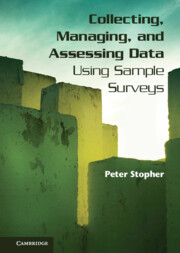Book contents
- Frontmatter
- Contents
- Figures
- Tables
- Acknowledgements
- 1 Introduction
- 2 Basic statistics and probability
- 3 Basic issues in surveys
- 4 Ethics of surveys of human populations
- 5 Designing a survey
- 6 Methods for conducting surveys of human populations
- 7 Focus groups
- 8 Design of survey instruments
- 9 Design of questions and question wording
- 10 Special issues for qualitative and preference surveys
- 11 Design of data collection procedures
- 12 Pilot surveys and pretests
- 13 Sample design and sampling
- 14 Repetitive surveys
- 15 Survey economics
- 16 Survey implementation
- 17 Web-based surveys
- 18 Coding and data entry
- 19 Data expansion and weighting
- 20 Nonresponse
- 21 Measuring data quality
- 22 Future directions in survey procedures
- 23 Documenting and archiving
- References
- Index
10 - Special issues for qualitative and preference surveys
Published online by Cambridge University Press: 05 June 2012
- Frontmatter
- Contents
- Figures
- Tables
- Acknowledgements
- 1 Introduction
- 2 Basic statistics and probability
- 3 Basic issues in surveys
- 4 Ethics of surveys of human populations
- 5 Designing a survey
- 6 Methods for conducting surveys of human populations
- 7 Focus groups
- 8 Design of survey instruments
- 9 Design of questions and question wording
- 10 Special issues for qualitative and preference surveys
- 11 Design of data collection procedures
- 12 Pilot surveys and pretests
- 13 Sample design and sampling
- 14 Repetitive surveys
- 15 Survey economics
- 16 Survey implementation
- 17 Web-based surveys
- 18 Coding and data entry
- 19 Data expansion and weighting
- 20 Nonresponse
- 21 Measuring data quality
- 22 Future directions in survey procedures
- 23 Documenting and archiving
- References
- Index
Summary
Introduction
Chapters 8 and 9 provide guidance on survey instrument design and question wording. However, there are some special issues that arise in qualitative and preference surveys that are dealt with separately in this chapter. These have to do with certain aspects of layout, question design, and question wording. Qualitative surveys or questions are those that address the reporting of people’s feelings, opinions, preferences, attitudes, values, and thoughts, as opposed to those that address the factual reporting of behaviours and situations. In the field of transport research, as in some areas of marketing and other fields, there is also a substantial and important area of work in what is variously called stated preference and stated choice experiments. These are qualitative experiments that are based more or less loosely on an area of psychological enquiry that was originally known as conjoint analysis. While it is not possible for a book such as this to go in depth into the psychological techniques themselves, there is much that can and should be covered in the design of surveys that are used in such fields of enquiry. At the same time, it also needs to be recognised that the dividing line between what represents an issue or question of survey design and what is actually an issue of the underlying psychological theory is often very blurred. As a result, there are issues that are discussed in this chapter that may seem at times to deal with the issues of the theory underlying the questioning.
Designing qualitative questions
Many of the issues discussed in Chapters 8 and 9 apply to the design of qualitative questions, and, indeed, qualitative questions have been used in some examples relating to the issues in those chapters. It is also appropriate to repeat the warning within Chapter 9 that any set of rules, guidance, or admonitions on survey design will have exceptions, and the survey designer must always consider the specific circumstances of the survey that he or she is designing. It is probably the case that just about every rule will have its exceptions. However, in this chapter, a number of further items of advice are offered with respect to the design of qualitative questions and preference surveys.
- Type
- Chapter
- Information
- Collecting, Managing, and Assessing Data Using Sample Surveys , pp. 199 - 210Publisher: Cambridge University PressPrint publication year: 2012



